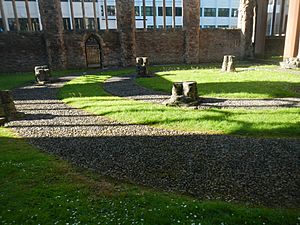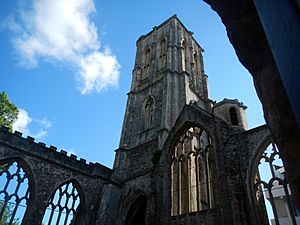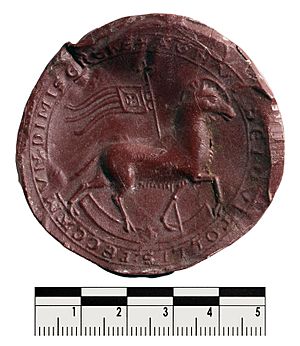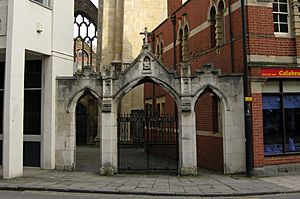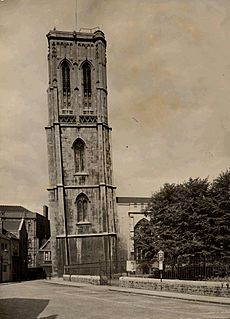Temple Church, Bristol facts for kids
Quick facts for kids Temple Church |
|
|---|---|
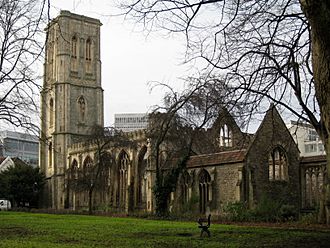
Temple Church, Bristol
|
|
| General information | |
| Town or city | Bristol |
| Country | England |
| Coordinates | 51°27′07″N 2°35′13″W / 51.452°N 2.587°W |
| Construction started | 12th century |
Temple Church, also known as Holy Cross Church, is a historic ruined church in Redcliffe, Bristol, England. It stands where an older, round church built by the Knights Templar once stood. They built it in the early 1100s on land given to them by Robert of Gloucester.
Later, in 1313, the Knights Hospitaller took over the church after the Templars were no longer active. They lost it in 1540 during a time when many monasteries were closed down. By the early 1300s, the church became the main church for the local area called Temple Fee. Around this time, people started rebuilding the church into a rectangular shape. This work finished by 1460, and a famous leaning tower was added.
The church was badly damaged during the Bristol Blitz in World War II. Today, it is a special historic building, owned by the Diocese of Bristol. Since 1958, English Heritage has helped look after it. In 1960, archaeologists found the layout of the 12th-century church, and its shape is now marked on the ground with stones.
Contents
The Church's Early Days
The first church built here in the 1100s was a Templar preceptory, which was like a headquarters for the Knights Templar. They built it on land given to them by Robert, Earl of Gloucester, before he passed away in 1147.
After the Knights Templar stopped operating, the Knights Hospitaller took over the church in 1313. However, in 1540, the English Crown took all the Hospitallers' properties. In 1544, Bristol Corporation bought the church.
The area around the church, called Temple Fee, became its own parish by 1308. Temple Fee and Redcliffe Fee were separate areas, divided by a "Law Ditch." Both areas became part of Bristol in 1373, ending a disagreement between Bristol and Somerset. Temple parish later joined the St Mary Redcliffe parish in 1956.
World War II Bombing
The church was hit by bombs on November 24-25, 1940, during the Bristol Blitz. This left it as an empty shell. The damage was very bad. Even though some parts of the church still stood, they were unsafe and have since been removed.
Some items from the church did survive the bombing. The metal screens that separated the side chapels are now in the Lord Mayor's Chapel. A special sword rest is also saved, though it is now in pieces in other churches. A 15th-century candelabrum, which is a large candle holder with a statue of the Virgin Mary, also survived. It is now in the Berkeley Chapel of Bristol Cathedral. The church also had eight bells, which were moved to Bristol Cathedral after the bombing.
Protecting the Historic Site
Temple Church was the first English parish church to be taken care of by the government's Ministry of Works. Today, English Heritage looks after it. The church is protected in two ways: it is a Grade II* listed building and a scheduled monument. This means it is very important and protected by law.
The archway and gates at the church entrance are also listed separately as Grade II. They were built in the mid-1800s from Portland stone and wrought iron in a Gothic Revival style.
From 2021 to 2023, English Heritage spent about £1 million to restore the site. This work allowed the public to visit the church for the first time in over thirty years.
Amazing Architecture
The original 12th-century church had a round main area called a nave, with an aisle around it. It also had a chancel with a semicircular end called an apse. This round chancel was later replaced with a rectangular one. A chapel was added to its north side in the late 1200s or early 1300s.
A second chapel was built later in the 1300s on the south side. In the 1400s, new windows were added to these chapels. These chapels were used by local groups, like the Bristol weavers, who were very important in the city's cloth industry.
The round nave was also replaced with a rectangular one, with aisles, around the late 1300s. The arches of the nave extended into the chancel.
A separate bell tower stood nearby until the early 1400s. The current leaning west tower was built in stages between 1441 and 1460. The top part of the tower leans differently from the bottom parts. This is because the builders tried to fix the lean as they built higher. The top of the tower leans about 1.64 meters (5.4 feet) from being straight. It is 114 feet (35 meters) tall. People often say the lean is because the tower was built on wool-sacks, but it's more likely due to the soft clay soil underneath.
Performance Events
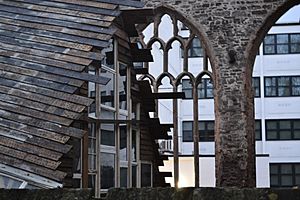
From October to November 2015, the church hosted an event called Sanctum. This was a performance created by American artist Theaster Gates and the art group Situations. A temporary auditorium was built inside the church using old materials from other parts of Bristol. This space was designed to make music and other performances sound amazing. These performances happened 24 hours a day for 24 days!
The church also took part in the 2023 Bristol Light Festival. It celebrated its reopening on February 3, 2023, after the big restoration project.
See also
- Grade II* listed buildings in Bristol
- Churches in Bristol


